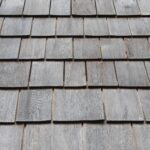Is your roof causing you concern? It’s important to keep an eye on the condition of your roof, as it plays a vital role in protecting your home from the elements. A damaged or neglected roof can lead to costly repairs, not to mention potential safety hazards.
The good news is that there are usually clear signs that indicate when your roof needs immediate attention. By knowing what to look out for, you can catch problems early and prevent them from escalating into more serious issues.
In this article, we’ll discuss five common signs that indicate it’s time to give your roof some TLC.
Key Takeaways
- Water damage is a clear sign that the roof needs immediate attention and can be caused by leaks, damaged shingles, or poor installation.
- A sagging roof can indicate structural issues caused by water damage or accumulated snow and can lead to serious problems such as leaks, mold growth, and collapse.
- Missing or damaged shingles should be addressed promptly to maintain roof integrity.
- Granule loss on shingles can expose roofing material to damage and should be addressed by a professional roofing contractor immediately. Signs of granule loss include piles of granules in gutters, discolored or faded shingles, increased utility bills, and nearing expected lifespan.
Water Damage
If you see water stains on your ceiling, it’s time to call a roofer ASAP before things get worse. Water damage is one of the most common problems that homeowners face with their roofs.
There are several causes of water damage, such as leaks in the roof, damaged shingles, or poor installation. Preventing water damage on roofs is essential to avoid costly repairs.
Regular maintenance and inspections can help detect any issues early on and prevent them from becoming more severe. It’s also crucial to keep gutters clean and free of debris to ensure proper drainage.
Remember that prevention is always better than cure when it comes to water damage on your roof.
Missing or Damaged Shingles
Don’t ignore missing or damaged shingles on your roof – they could lead to costly repairs down the line. Shingles protect your roof from harsh weather conditions and keep your home safe and dry.
If you notice any missing or damaged shingles, it’s important to address the issue as soon as possible. Replacing missing or damaged shingles is crucial in maintaining the integrity of your roof.
You can choose to do it yourself, but it’s highly recommended to hire a professional for shingle replacement. A professional inspection can also help identify other potential issues with your roof before they become bigger problems that require more extensive repairs.
Don’t wait until it’s too late – take care of any missing or damaged shingles promptly to avoid more expensive fixes in the future.
Sagging Roof
Your roof may start to sag over time, giving the appearance of a drooping or curved surface that could indicate structural issues. This is usually caused by either the weight of accumulated snow or water damage due to poor drainage and ventilation. If left unaddressed, a sagging roof can lead to more serious problems such as leaks, mold growth, and even collapse.
It’s important to address sagging roofs immediately to prevent further damage and ensure your safety. Here are some common causes of sagging roofs:
| Causes | Description |
|---|---|
| Water Damage | Poor drainage and ventilation can cause water damage that weakens the structure of your roof over time. |
| Accumulated Snow | Heavy snow can put a significant amount of weight on your roof, causing it to sag under the pressure. |
Don’t wait until it’s too late – if you notice any signs of a sagging roof, contact a professional roofing contractor right away. They can assess the extent of the damage and recommend appropriate repairs or replacement options to keep your home safe and secure.
Granule Loss
You may notice that the shingles on your roof are losing their granules, which can be a sign of wear and tear over time. Granules provide a protective layer for your roof by reflecting sunlight and preventing damage from harsh weather. When these granules start to fall off, it exposes your roofing material to potential damage.
Here are some signs that you may need immediate attention for granule loss on your roof:
- You notice piles of granules in your gutters or at the base of downspouts.
- Your shingles appear discolored or faded due to the loss of granules.
- Your utility bills have increased as a result of decreased insulation caused by worn out shingles.
- Your roof is nearing its expected lifespan, and repairs may be more expensive than replacement costs.
If you’re experiencing any of these signs, it’s important to contact a professional roofing contractor immediately to assess the situation. The cost for repairing or replacing your roof will vary depending on factors such as roofing material types, size of the area needing repair/replacement, and labor costs involved. Don’t wait until it’s too late; address any issues with granule loss promptly to ensure the longevity and safety of your home’s roofing system.
Age
As your roof ages, it may become more susceptible to wear and tear, potentially leading to costly repairs or replacement. It’s important to keep an eye on the age of your roof and be proactive in maintaining it.
Regular roof inspections can help identify any potential issues before they turn into major problems. One of the best maintenance tips for an aging roof is to keep it clean and free from debris. This will prevent water from pooling on the surface, which can lead to leaks and damage over time.
Additionally, you should make sure that any trees or branches near your roof are trimmed back so that they don’t rub against the surface and cause damage. By staying on top of regular maintenance tasks like these, you can extend the life of your aging roof and avoid costly repairs down the line.
DIY Repairs
If you’re looking to save money on roof repairs and feel confident in your DIY skills, tackling minor repairs yourself can be a great option. However, it’s important to note that not all roof problems can be fixed with a simple DIY solution.
It’s crucial to conduct a thorough roof inspection before attempting any repairs, as there may be underlying issues that require professional assistance.
Some common DIY roof repairs include fixing small leaks, replacing damaged shingles or tiles, and cleaning out gutters. These tasks are relatively easy to do on your own and can help prevent further damage to your roof.
However, if you notice significant damage such as large holes or extensive water damage, it’s best to leave the repairs to the experts. Attempting complex repairs without the necessary knowledge and equipment can lead to more costly damages down the line.
Remember: safety should always come first when working on your roof!
Frequently Asked Questions
How much does it cost to replace a roof?
If you need to replace your roof, the cost can vary depending on factors like materials used and size of your home. Ignoring damage can lead to health hazards, so take precautions and address issues promptly.
Can a damaged roof cause health problems for me and my family?
If you have a damaged roof, it can cause indoor air quality issues, leading to allergies and mold growth. It can also impact energy efficiency and create safety hazards. Proper roof maintenance and repairs by roofing contractors or DIY efforts can prevent these problems.
What is the average lifespan of a roof?
Your roof’s lifespan depends on the material and climate. Asphalt shingles last about 20 years, while metal roofs can last up to 50. Regular maintenance can extend your roof’s life, but eventually, you’ll need to consider your roof replacement options. Here are some helpful roof maintenance tips.
Can I claim insurance for roof repairs?
You may be able to claim insurance coverage for roof repairs, but it depends on your policy. Regular roof maintenance can help prevent the need for major repairs and increase the likelihood of insurance coverage.
How can I prevent my roof from getting damaged?
To prevent roof damage, regularly maintain your roof by cleaning gutters and inspecting for any wear and tear. Consider protective coatings or installing rainwater harvesting systems or solar panels to reduce the impact of weather conditions.












